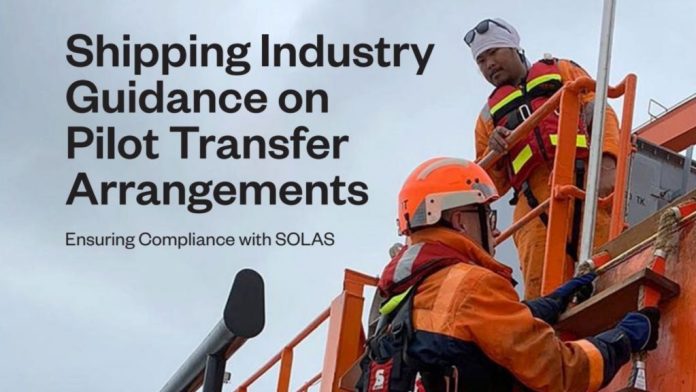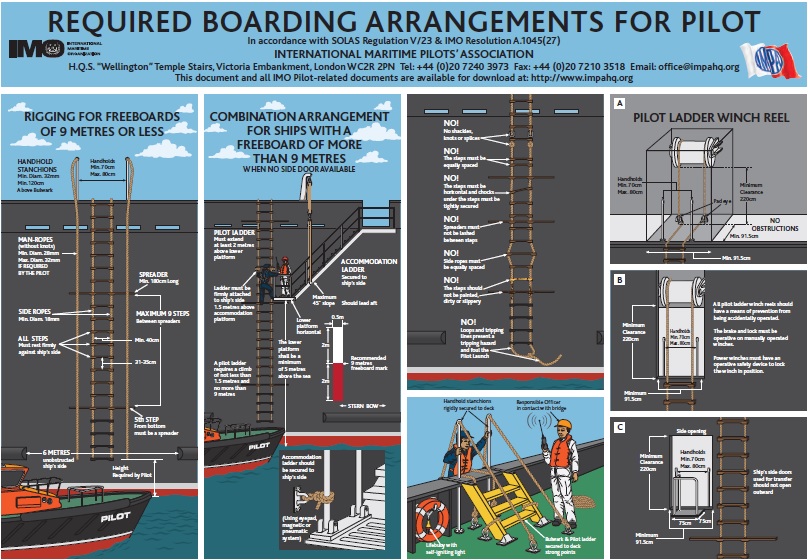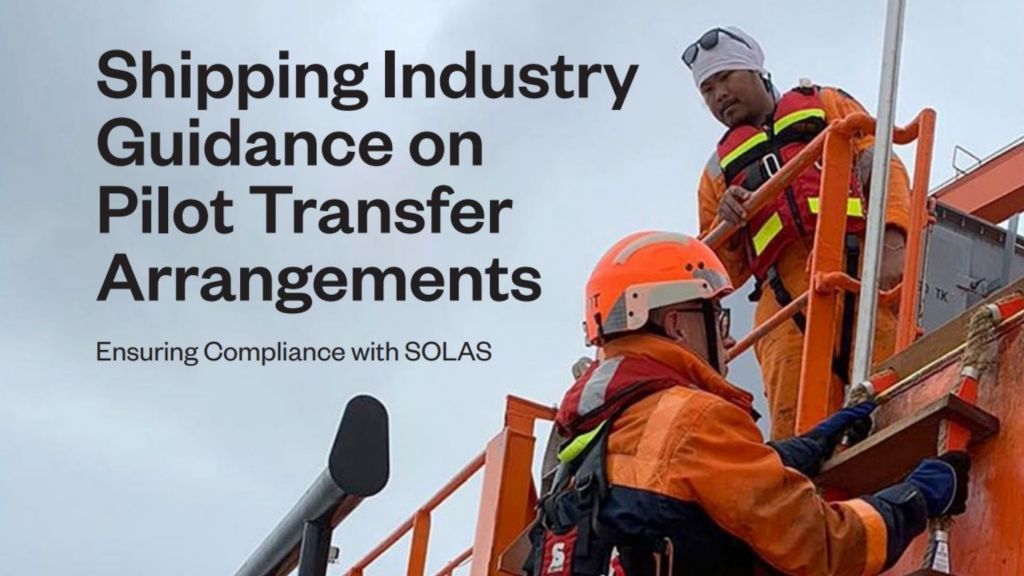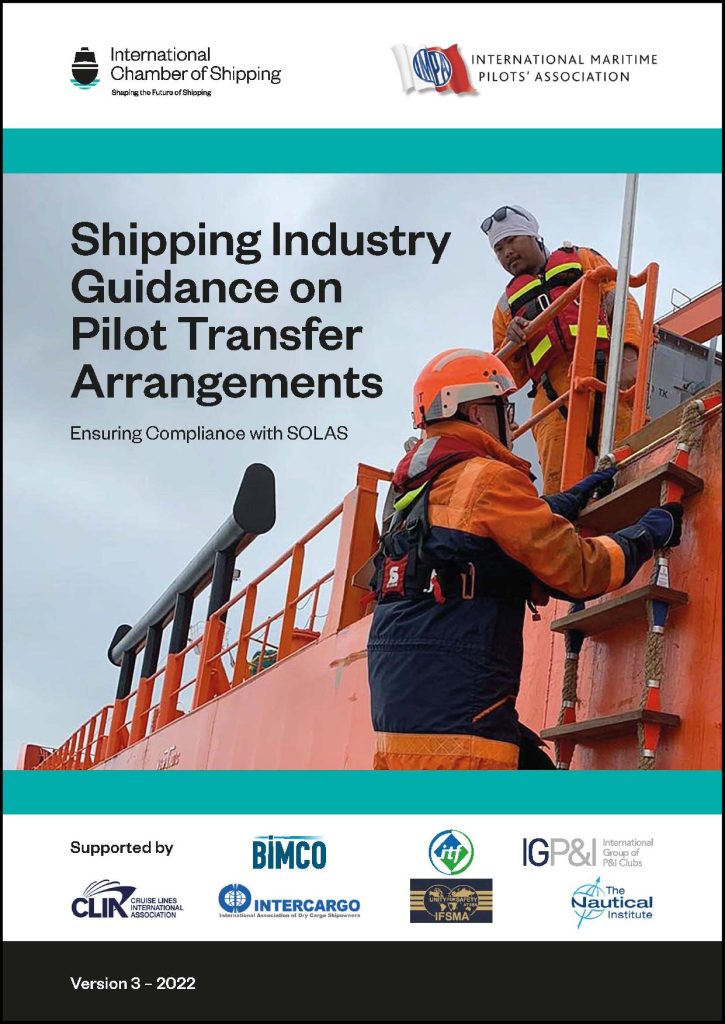
(www.MaritimeCyprus.com) This article aims to remind shipowners, operators, masters, crews, ROs, marine pilots and pilotage providers of the obligation to provide safe pilot transfer arrangements. There are frequent incidents where pilots’ lives have been placed at risk around the world, when man ropes have parted or its securing point has failed. In addition, there are frequent reports and complaints about non-compliant pilot transfer arrangements.
Shipowners, operators, masters and crews are reminded that pilot transfer arrangements, including pilot ladders, must comply with the obligations under the International Convention for the Safety of Life at Sea (SOLAS) Chapter V Regulation 23.
Pilot transfer arrangement standards
Whenever a pilot or other person embarks or disembarks from a ship by ladder, they entrust their safety to the pilot transfer arrangements provided by the ship and the pilot boat crew.
The requirements in SOLAS V/23 are the minimum standards for equipment installed and arrangements for pilot transfers on ships on or after 1 July 2012. The IMO standards can be found in IMO Resolution A.1045(27) “Pilot transfer arrangements and IMO Resolution A.1108(29) “Amendments to the Recommendations on Pilot Transfer Arrangements (Resolution A.1045(27)).
SOLAS V/23.2.3 also states that a pilot ladder shall be certified by the manufacturer as complying with V/23 or “with an international standard acceptable to the Organization” and refers to ISO 799:2004 “Ships and marine technology – pilot ladders”.
Compliance with this particular provision of SOLAS V/23 can be met when a manufacturer has certified that the pilot ladder complies with either of the above standards, noting they are not identical.
Paragraph 10.1 of Part A of the International Safety Management Code (ISM) requires that vessel operators establish procedures to ensure that a ship is maintained in conformity with the relevant rules and regulations, including pilot transfer arrangements. Such procedures should include regular inspections of the pilot transfer arrangement and storage of such equipment when not in use.

Pilot transfer arrangements
IMO Circular MSC.1/Circ.1428 illustrates the pilot transfer arrangements required by SOLAS V/23.
Strict attention should be paid to the freeboard of the vessel to determine whether a combination ladder needs to be rigged and, if a combination ladder is required, attention should be paid to arrangements for securing such ladders to the vessel’s side.
Clear and efficient communication with the pilot boat master is essential to ensure the safety of the pilot transfer arrangements before a person uses the ladder. The pilot boat master is best positioned to judge correct height of the bottom of the ladder and identify any potential issues with the ladder or ropes once in place.
Responsibility
Responsibility for safe practices for personnel transfers rests with each person involved in the activity including the vessel’s owners, operators, master and crew, pilotage providers, pilots and pilot boat crew, as well as the person being transferred. All parties should observe both the spirit and intent of the regulations, to ensure safety is not compromised.
Where a marine pilot suspects that the pilot transfer arrangement provided is unsafe, they should refuse to use the arrangement until it is made safe by the master and crew.
Implementation of standards
When conducting port State control inspections, inspectors will pay particular attention to the material state of all equipment and the implementation Res.A.1045(27), MSC.1/Circ.1428 and MSC.1/Circ.1495/Rev.1.
Compliance with the referenced standards does not of itself assure safety in each case. Therefore, the Master or responsible officer supervising the rigging of the pilot transfer arrangements should assess whether supplementary measures, such as lifejackets, harnesses, lifelines and lifebuoys be made available to enhance the safety of personnel using the pilot transfer arrangement.
Latest guidance paper
This guidance is intended to remind seafarers and companies of the vital importance of adhering to the rules and established procedures concerning the provision of safe boarding arrangements for pilots.
Pilots have the right to decline to board vessels offering defective boarding arrangements, which can result in serious delay. Pilots are also entitled to report defects in boarding arrangements to port state control authorities, which could lead to a full port state control inspection with the risk of delay and financial penalties.
A pilot who has climbed a correct ladder, well rigged, and attended by an officer and a deck party will be in the right frame of mind to give their best attention to the safety of the vessel.
The International Chamber of Shipping (ICS) and International Maritime Pilots’ Association (IMPA) have produced this guidance in collaboration with industry partners; Baltic and International Maritime Council (BIMCO), Cruise Lines International Association (CLIA), International Group of Protection and Indemnity Clubs (IGP&I), International Federation of Shipmasters’ Associations (IFSMA), INTERCARGO, International Transport Workers’ Federation (ITF) and The Nautical Institute.
New in this version:
A new section outlining the International Maritime Organization (IMO) guidance on combination embarkation platform arrangements has been added.
Click below to download Shipping Industry Guidance on Pilot Transfer Arrangements, Third Edition:
Click image below to download the "Pilot Ladder Safety Guide" from The American Club":
This safety video examines the safe set-up of pilot ladders and details the safety checks that should be carried out before using a plot ladder to ensure a safe boat transfer.















